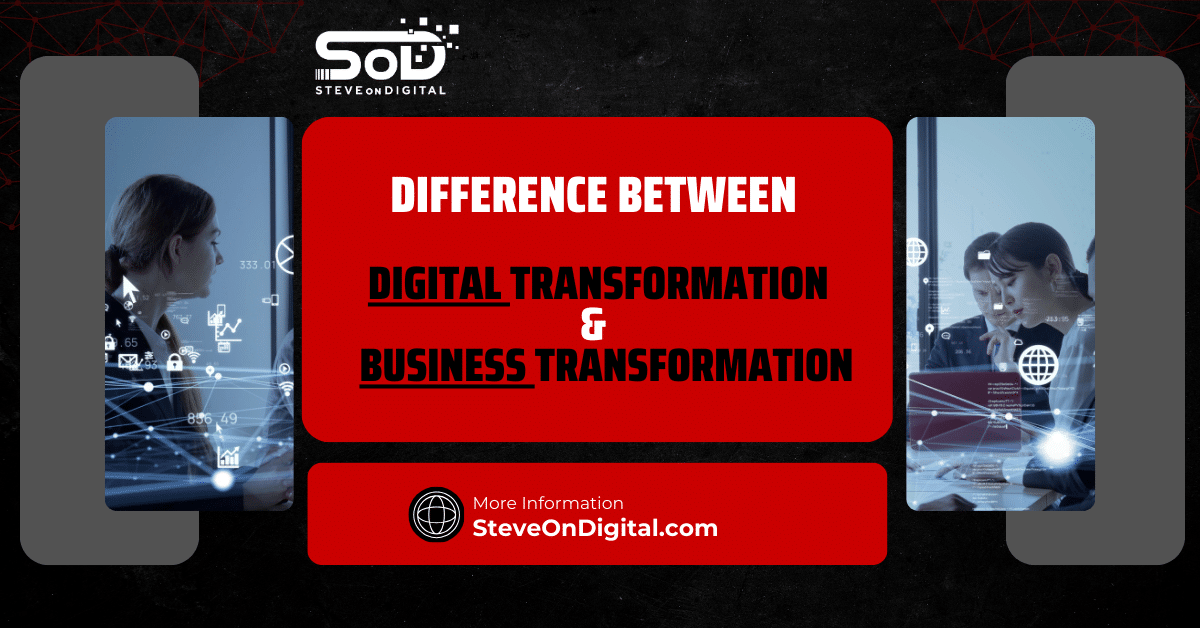An IT roadmap aligns technology initiatives with business objectives, enhancing decision-making and operational efficiency. It helps prioritize projects, allocate resources effectively, and supports digital transformation efforts.
As a small business owner, I’ve found that having a clear IT roadmap prevents uncoordinated technology efforts, allowing for better planning and adaptability to technological advancements. This strategic tool is essential for staying competitive, improving productivity, and achieving long-term growth.
Developing an IT roadmap involves setting strategic goals, identifying key initiatives, and engaging stakeholders, ensuring your business can navigate the fast-paced tech landscape successfully.
I’m Steve, a digital transformation expert with a strong background in electrical engineering, an MBA, and a master’s in Project Management. I excel at helping SMEs navigate the digital landscape with practical insights. Let’s begin!
Understanding An IT Roadmap
As a small business owner, you might often feel overwhelmed by the fast pace of technological advancements. That’s where an IT roadmap comes in handy. Think of it as a strategic plan that outlines how your business can leverage technology to achieve its objectives.
Definition Of An IT Roadmap
An IT roadmap is essentially a high-level document that maps out the technology strategy for your business. It includes your business objectives, technology initiatives, and key milestones. Components such as a comprehensive technology roadmap, it project roadmap, and technology strategy framework make it a robust guide for IT planning.
Purpose Of An IT Roadmap
The primary purpose of an IT roadmap is to align your technology initiatives with your business goals. It acts as a blueprint, helping you prioritize projects, allocate resources efficiently, and ensure that every IT decision supports your broader strategic objectives. By having a clear plan, you avoid the chaos of uncoordinated technology efforts.
Importance In Modern Business
In today’s competitive business landscape, an IT roadmap is crucial. It helps small businesses like yours stay on the same page with technology trends and demands. With a clear roadmap, you can make informed decisions, improve operational efficiency, and gain a competitive edge. Technology roadmaps today are more than just static documents; they are dynamic tools that evolve with your business needs.
Key Benefits Of An IT Roadmap
An IT roadmap offers numerous benefits, especially for small businesses. From aligning IT with business objectives to enhancing operational efficiency, the advantages are manifold.
| Key Benefit | Description |
|---|---|
| Aligning IT with Business Objectives | Ensures IT projects support business goals and provides a clear link between IT investments and outcomes. |
| Improved Decision Making | Enables better prioritization of initiatives based on strategic importance and impact. |
| Enhanced Operational Efficiency | Streamlines operations, reduces redundancies, and optimizes tech stack for cost savings and productivity. |
Aligning IT With Business Objectives
One of the biggest benefits of an IT roadmap is its ability to align your IT projects with your business objectives. It ensures that every technology initiative supports your business goals, providing a clear link between IT investments and business outcomes.
Improved Decision Making
Having an IT roadmap allows for better decision-making. With a well-defined plan, you can prioritize initiatives based on their strategic importance and potential impact. This leads to more informed and strategic decisions, reducing the risk of costly mistakes.
Enhanced Operational Efficiency
An IT roadmap can significantly enhance your operational efficiency. By having a clear plan, you can streamline your operations, reduce redundancies, and optimize your tech stack. This not only saves money but also improves overall productivity.
Components Of An IT Roadmap
A successful IT roadmap comprises several key components, each playing a crucial role in guiding your technology strategy.
| Component | Description |
|---|---|
| Strategic Objectives | Provide direction and purpose, ensuring alignment with business goals. |
| Technology Initiatives | Specific projects and activities planned to achieve strategic objectives. |
| Key Milestones | Critical checkpoints to track progress and maintain momentum towards achieving objectives. |
Strategic Objectives
Strategic objectives form the backbone of your IT roadmap. They provide direction and purpose, ensuring that your technology initiatives are aligned with your business goals. These objectives should be clear, measurable, and achievable.
Technology Initiatives
Technology initiatives are the specific projects and activities you plan to undertake to achieve your strategic objectives. These could include adopting new software, upgrading existing systems, or implementing new technologies. Each initiative should be carefully planned and prioritized based on its importance and feasibility.
Key Milestones
Key milestones are critical checkpoints in your IT roadmap. They help track progress and ensure that your projects stay on schedule. By setting short-term goals and long-term vision, you can maintain momentum and achieve your strategic objectives efficiently.
Short-Term Goals
Short-term goals focus on immediate priorities that can deliver quick wins. These might include simple upgrades or small projects that provide immediate value.
Long-Term Vision
Long-term vision involves planning for future success. It’s about setting ambitious goals that will drive your business forward and ensure long-term growth and sustainability.
Creating An Effective IT Roadmap
An effective IT roadmap is a game-changer for any business. It provides a clear path, helping you navigate through the technological landscape. I’ve crafted several IT roadmaps over the years, and the key is to break it down into manageable steps.
| Step | Description |
|---|---|
| Assessing Current State | Evaluate the current IT environment, identify gaps, and areas needing improvement. |
| Setting Strategic Goals | Define clear and achievable goals that align with business objectives. |
| Identifying Key Initiatives | Prioritize technology initiatives based on their impact and feasibility. |
| Involving Stakeholders | Engage key stakeholders throughout the planning process for comprehensive input and buy-in. |
Assessing Current State
Before you can move forward, you need to understand where you stand. Evaluating your current IT environment is the first step. Take stock of your existing systems, tech stack, and any ongoing technology projects. Identify gaps and areas that need improvement. This assessment forms the foundation of your IT roadmap.
Setting Strategic Goals
Next, set clear and achievable strategic goals. These goals should align with your business objectives. For example, if one of your business goals is to improve customer satisfaction, a related IT goal might be to implement a new customer feedback system. Strategic planning is crucial here. Define what success looks like for your technology initiatives.
Identifying Key Initiatives
Once your goals are clear, identify the key technology initiatives that will help you achieve them. Prioritize these initiatives based on their impact and feasibility. This could involve upgrading your infrastructure, adopting new software, or investing in cybersecurity measures. The goal is to create technology roadmaps that are actionable and aligned with your strategic objectives.
Involving Stakeholders
Involving key stakeholders in the planning process is essential. This includes your IT team, key stakeholders, and even some end-users. Their input ensures that the roadmap is comprehensive and considers various perspectives. I’ve found that this collaborative approach leads to better buy-in and smoother implementation.
Role Of Technology Roadmaps In Digital Transformation
Digital transformation is a buzzword these days, but it’s more than just a trend. It’s about changing how you work and provide value to customers using technology. An IT roadmap plays a crucial role in this process.
Supporting Digital Adoption
An IT roadmap supports digital adoption by providing a clear plan for integrating new digital tools and processes. This could include adopting a digital adoption platform or rolling out new software. By having a roadmap, you can manage these changes more effectively and avoid disruptions to your business operations.
Facilitating Change Management
Change can be challenging, especially when it involves technology. An IT roadmap helps manage this change by outlining the steps and strategies needed to implement new systems. It acts as a guide, helping your team adjust to new ways of working and ensuring a smooth transition.
IT Roadmaps And Business Strategy
The connection between IT roadmaps and broader business strategies is vital. They should work hand-in-hand to drive your business forward.
Integrating IT Roadmaps With Business Plans
To be effective, your IT roadmap needs to be integrated with your overall business plans. This means ensuring that your technology initiatives support your business goals. For instance, if your business plan includes expanding into new markets, your IT roadmap might include initiatives to support this expansion, such as scaling your IT infrastructure or enhancing your e-commerce platform.
Aligning With Business Goals
Aligning your IT initiatives with your business goals ensures that every technology investment delivers tangible value. It helps in making informed decisions that are in line with your strategic objectives. This alignment is crucial for maximizing the return on your technology investments and achieving your company’s broader strategic goals.
Monitoring Progress And Measuring Success
Creating an IT roadmap is only half the battle. To reap the benefits of an IT roadmap, you need to monitor its progress and measure its success. This is where tracking key performance indicators (KPIs) and conducting regular reviews come into play.
Key Performance Indicators (KPIs)
KPIs are critical metrics that help you track the performance of your IT initiatives. For example, if one of your strategic objectives is to improve customer satisfaction, you might track metrics such as customer feedback scores or response times. Identifying the right KPIs allows you to measure tangible value and ensure that your technology investments are yielding the desired results.
Regular Review And Updates
An IT roadmap is not a static document. It needs to evolve as your business grows and the technology landscape changes. Regular reviews and updates are essential to keep your roadmap relevant. This involves reassessing your strategic objectives, technology initiatives, and key milestones periodically. By doing so, you can make informed decisions and adjust your plans to stay on track.
Tools And Techniques For IT Roadmapping
To create and maintain an effective IT roadmap, you need the right tools and techniques. From project management tools to dedicated road mapping tools, these resources can help you streamline the process.
| Tool/Technique | Description |
|---|---|
| Project Management Tools | Tools like Asana, Trello, and Jira help organize tasks, set deadlines, and monitor progress. |
| Dedicated Roadmapping Tools | Tools such as Aha! and Roadmunk offer features tailored for creating and managing roadmaps. |
Project Management Tools
Project management tools like Asana, Trello, and Jira are invaluable when it comes to roadmapping. They help you organize tasks, set deadlines, and monitor progress. By using a project management tool, you can ensure that all your technology projects are aligned with your roadmap and stay on schedule.
Dedicated Roadmapping Tools
There are also specific tools designed for roadmapping, such as Aha! and Roadmunk. These tools offer features tailored for creating and managing roadmaps. They allow you to visualize your plans, track progress, and collaborate with your team. Using a dedicated roadmapping tool can provide a deeper understanding of your roadmap and help you deliver tangible results.
Case Studies And Examples
Sometimes, real-life examples can illustrate the benefits of an IT roadmap better than theory. Here are two case studies that highlight how different businesses have successfully implemented their IT roadmaps.
Here is a table with the case studies, business types, key initiatives, and outcomes:
| Case Study | Business Type | Key Initiatives | Outcome |
|---|---|---|---|
| Medium-Sized Business | Retail | Upgraded e-commerce platform, adopted digital adoption platform | Improved operational efficiency and customer satisfaction. |
| Large Enterprise | Healthcare | Adopted health informatics systems, enhanced data security | Achieved strategic goals and maintained competitive advantage. |
Case Study 1: A Medium-Sized Business
In this case study, a medium-sized business in the retail sector implemented an IT roadmap to support its digital transformation efforts. They started by assessing their current state and identifying key initiatives such as upgrading their e-commerce platform and adopting a new digital adoption platform. By setting clear strategic objectives and tracking relevant KPIs, they were able to improve operational efficiency and enhance customer satisfaction.
Case Study 2: A Large Enterprise
A large enterprise in the healthcare industry created a comprehensive technology roadmap to align its IT strategy with its business objectives. The roadmap included technology initiatives like adopting new health informatics systems and enhancing data security measures. By involving key stakeholders and conducting regular reviews, they managed to achieve their strategic goals and maintain a competitive advantage in the market.
Potential Challenges And Solutions
While an IT roadmap offers numerous benefits, there are potential challenges you might face during its implementation. Here are some common challenges and how to overcome them.
Identifying Gaps In Resources
One of the main challenges is identifying gaps in resources. This could be in terms of budget, personnel, or technology. To address this, conduct a thorough assessment of your current resources and identify what you need to achieve your strategic objectives. Prioritize initiatives that deliver the most value and allocate resources accordingly.
Managing Stakeholder Expectations
Managing stakeholder expectations can also be tricky. It’s important to communicate clearly and involve stakeholders throughout the planning process. This ensures that everyone is on the same page and supports the roadmap. Use project management tools to keep stakeholders informed and engaged, and regularly update them on progress and any changes to the plan.
Best Practices For IT Roadmapping
Over the years, I’ve learned that following certain best practices can make a significant difference when developing an IT roadmap. These practices help ensure the roadmap is not just a document but a strategic tool that drives your business forward.
Continuous Stakeholder Engagement
One of the key practices is maintaining continuous engagement with stakeholders. This includes your IT team, key stakeholders, and even customers. Regular communication helps in aligning everyone’s expectations and ensures that the roadmap remains relevant. For instance, involving your product managers and customer feedback teams can provide valuable insights into what technological advancements are needed. This cross functional collaboration fosters a shared understanding and helps in creating a comprehensive technology roadmap.
Flexibility And Adaptability
Another crucial practice is ensuring that your IT roadmap is flexible and adaptable. The technology landscape is constantly evolving, and your roadmap should be able to adapt to these changes. Regularly review and update your roadmap to reflect new business objectives, technological advancements, and market trends. Flexibility in your strategic planning allows you to pivot when necessary, ensuring that your business remains competitive and responsive to changes.
Final Thoughts
In conclusion, the benefits of an IT roadmap are numerous and impactful. From aligning your technology initiatives with business goals to improving decision-making and operational efficiency, an IT roadmap is an essential tool for any business, especially small ones. It provides a clear path for digital transformation efforts, supports strategic planning, and helps manage technology investments effectively.
By following best practices like continuous stakeholder engagement and maintaining flexibility, you can create a technology roadmap that not only meets your current needs but also adapts to future challenges. Whether you’re dealing with potential challenges or identifying gaps in resources, an IT roadmap offers a structured approach to navigating the complexities of technology management.
Remember, an IT roadmap is not just about planning; it’s about creating a strategic framework that drives your business forward. By leveraging tools like project management tools and dedicated roadmapping tools, and integrating your IT roadmap with your broader business strategy, you can achieve your company’s broader strategic goals and deliver tangible value.
In my experience, a well-crafted IT roadmap can transform your business operations, enhance your competitive advantage, and ultimately lead to long-term success. So, take the time to develop a detailed and adaptable IT roadmap that aligns with your business objectives and prepares you for the future.




